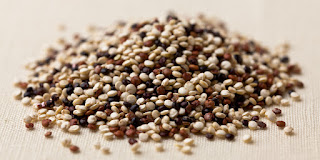This week's recipe is brought to you by...me! I offer up to you my
FOCACCIA BREAD RECIPE
- super easy and so tasty
- super easy and so tasty
Ingredients:
- 30 oz / 7 cups high gluten or bread flour
- 0.6 oz / 2 teaspoons salt
- 0.1 oz / 1 teaspoon yeast
- 30.7 oz / 4 cups lukewarm water
- 1.6 oz / 4 tablespoons + extra for drizzling, olive oil
I've offered ingredients in both volume and weight measurements. Most bakers use weight because it's a more accurate way to measure an ingredient like flour - which can vary greatly in volume depending on who scoops it!
Love the simplicity of the ingredients in this recipe:
Step 1: Weigh/measure and mix first four ingredients together in the bowl of an electric mixer or by hand in a large mixing bowl. In a separate bowl combine the water and olive oil.
Step 2: Using the paddle attachment for the electric mixer or a large wooden spoon begin adding the wet ingredients to dry while the mixer is running on low or while you are stirring. Be sure all the flour is completely hydrated and you break up any clumps that have formed in the dough. Scrape down the sides and bottom of the bowl with a spatula to incorporate all ingredients evenly. Continue mixing until you have a "pancake batter" consistency, except without any lumps. When you are finished mixing the dough should be smooth and elastic.
In this photo the dough needs to continu being mixed until all the lumps are removed.
Step 3: Pour the dough (and it should pour because of how "batter-like" it is. If your dough seems stiff or dry, add water until you reach the desired consistency.) onto a baking sheet lined with parchment paper and generously greased. I prefer to use PAM spray for convenience sake and because it coats the pans evenly. Allow dough to rest for 20 minutes - this helps relax the gluten and will make shaping in the next step much easier.
Step 4: After you've given the dough a "good rest", using damp fingers begin to gently spread the dough out over the entire pan. I have a bowl of water next to me during this process so I can dampen my fingers again when the dough starts sticking to them.
Once you have completely strechted the dough to fit the pan, coat the surface with oil and cover tightly with plastic wrap. Try to avoid the plastic wrap touching the dough as it will stick to it! Allow the dough to rise in a warm place 1-2 hours, until it has doubled its height in the pan.
Step 5: Preheat oven to 500 degrees. Once the dough has risen to the desired height, again using damp fingers, begin to dimple the dough, pressing it down to the bottom of the pan. This is also my favorite step in the recipe, sometimes it's fun to get our hands a little dirty.
Generously drizzle olive oil all over the surface of the dough, enough to pool in the dimples you created. Now sprinkle with sea salt and bake in preheated oven for 10 minutes. After 10 minutes rotate the pan and bake for another 10 minutes or until the focaccia is a nice golden brown. Remove from oven and allow bread to cool completely (the biggest challenge for me!) before cutting.
























